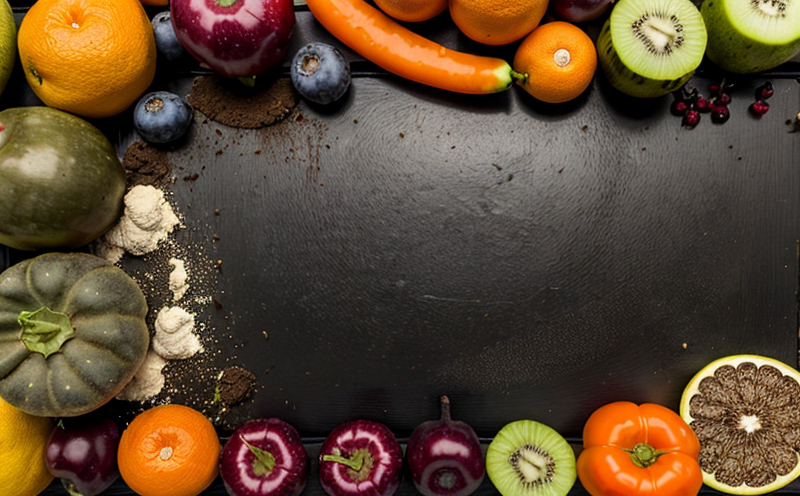ISO 6635 Vitamin C Analysis in Citrus Fruits
The analysis of ascorbic acid (vitamin C) content in citrus fruits is critical for ensuring product quality, compliance with international standards, and maintaining consumer trust. ISO 6635 provides a robust framework to accurately quantify vitamin C levels, which is essential for industries such as food processing, nutrition supplements, and agriculture.
Vitamin C (ascorbic acid) plays an important role in numerous biological processes including the prevention of oxidative stress, supporting immune function, and aiding in collagen synthesis. Accurate measurement ensures that products meet specified nutritional claims and comply with regulatory requirements. This service utilizes advanced analytical techniques to determine ascorbic acid content in citrus fruits.
Our laboratory adheres strictly to ISO 6635 methodology which involves several key steps: sample preparation, extraction of ascorbic acid, derivatization if necessary, and quantification using a suitable analytical method such as high-performance liquid chromatography (HPLC).
The process begins with proper sample handling. Citrus fruit samples are carefully selected based on maturity level, ripeness, and potential contamination factors. Samples are then weighed accurately before being homogenized in appropriate solvents. Depending on the specific requirements of ISO 6635, various extraction methods may be employed to liberate ascorbic acid from its natural matrix.
After successful extraction, derivatization might be required if direct detection by HPLC proves challenging or less sensitive. Derivatives are then injected into the chromatographic column where they separate according to their molecular structure and size. Detection occurs through ultraviolet-visible (UV-Vis) absorption at a wavelength specific for ascorbic acid.
The quantification process yields results expressed in milligrams per kilogram (mg/kg), reflecting the concentration of vitamin C present in the sample. This value can be used to assess product quality, compare different batches or growing seasons, and ensure adherence to established standards.
| Sample Preparation | Extraction Method | Derivatization (if needed) | Detection Technique |
|---|---|---|---|
| Weighing and homogenization | Aqueous extraction or ultrasound-assisted extraction | Optional, based on method sensitivity | HPLC with UV-Vis detection |
This service not only provides accurate quantification of vitamin C but also helps clients understand the intricacies involved in its measurement. By adhering to ISO 6635 guidelines, we ensure reliable and reproducible results that are crucial for quality assurance programs.
Understanding the methodology behind this analysis is beneficial for those responsible for maintaining high standards in food production and processing. Regular monitoring of vitamin C levels allows companies to make informed decisions about ingredient sourcing, formulation adjustments, and labeling practices.
Applied Standards
The primary standard applied for this service is ISO 6635:1984 "Vitamin C in citrus fruits - Determination by high-performance liquid chromatography". This international standard specifies procedures for the determination of ascorbic acid content in citrus fruits using HPLC with UV-Vis detection.
ISO 6635 ensures consistency across laboratories worldwide, providing a standardized approach to vitamin C analysis. Adherence to this protocol guarantees accurate and comparable results regardless of geographical location or laboratory setup.
Benefits
Utilizing ISO 6635 for vitamin C analysis offers numerous benefits:
- Enhances product quality by ensuring accurate nutrient content.
- Facilitates compliance with international regulations and standards.
- Supports research and development efforts aimed at improving nutritional profiles.
- Provides a reliable basis for marketing claims related to vitamin C intake.
By leveraging this service, clients gain valuable insights into the quality of their citrus fruit products. These data enable better decision-making processes regarding ingredient selection, formulation adjustments, and packaging strategies.
Industry Applications
- Food Processing: Ensure consistent vitamin C levels in processed citrus products like juices, jams, and jellies.
- Nutrition Supplements: Verify the potency of vitamin C supplements derived from citrus fruits.
- Agriculture: Monitor ascorbic acid content during different stages of cultivation to optimize growing conditions.
The table below highlights various applications and scenarios where ISO 6635 analysis proves particularly useful:
| Industry | Purpose |
|---|---|
| Food Processing | Quality control for processed citrus products |
| Nutrition Supplements | Verification of supplement potency |
| Agriculture | Optimization of growing conditions |





